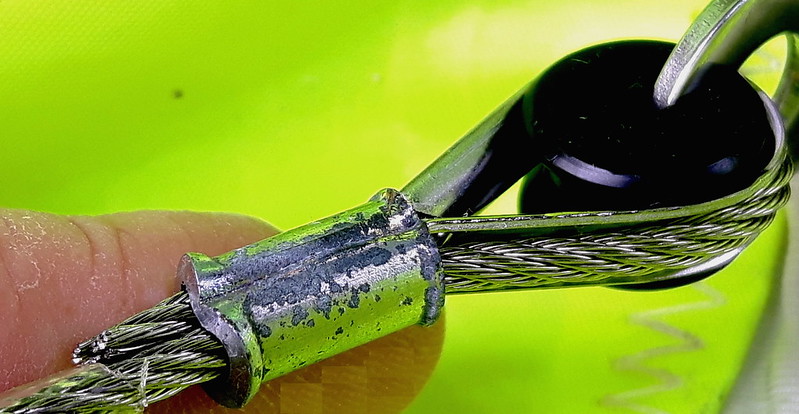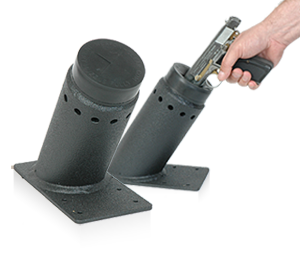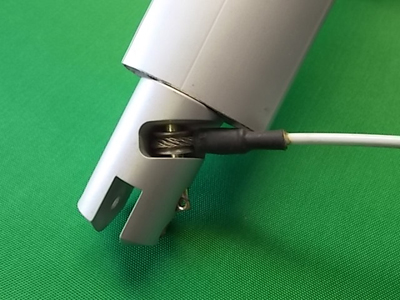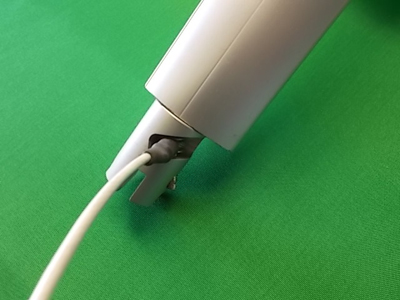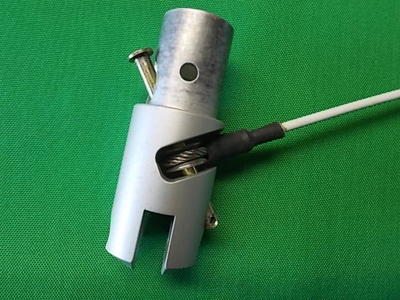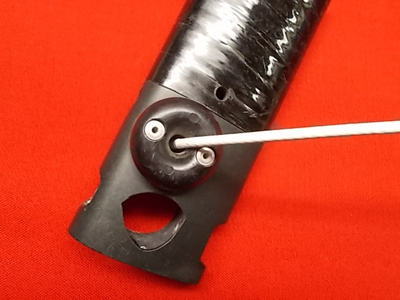http://www.hanggliding.org/viewtopic.php?t=35187
Nicopress corrosion - is this what it looks like?
Rcpilot - 2017/03/21 15:25:34 UTC
http://willswing.com/wp-content/uploads/manuals/Alpha_June_2015.pdf
While pushing up on the leading edge between the nose and the crossbar junction, step on the bottom side wire with about 75 lbs. of force. This is a rough field test of the structural security of the side wire loop, the control bar, the kingpost, and the crossbar, and will likely reveal a major structural defect that could cause an in-flight failure in normal operation.
And CAUSE a major structural INsecurity when I grind the bottom sidewire into a sharp rock. Fuckin' morons.
2017/03/21 16:24:12 UTC - 3 thumbs up - NMERider
2017/03/21 16:49:32 UTC - 3 thumbs up - Brian Scharp
NMERider - 2017/03/21 16:37:59 UTC


The same illustrations appear in multiple manuals.
- ALL Wills Wing gliders that aren't museum pieces.
- I can't believe I've been this stupid:
Tad Eareckson - 2017/03/24 04:39:11 UTC
- If it were humanly possible to trash something on a glider by doing a stomp test - and I'm far from sure that it is - it wouldn't be a wire. Note that Wills Wing tells you to only stomp a T2 wire with two thirds of what they tell you to stomp a U2. That's not because they're using lighter wires on their toplesses.
...for this long. But Wills Wing doesn't win any awards on this one either. I've never understood WHY they have you doing a substantially lighter test for toplesses. On a kingposted glider it's impossible to torque your wing to negative dihedral due to the restriction from the top sidewires. Duh. So you're not getting as good a preflight wire load test on your T2C - the glider you're gonna be more inclined to loop. Thanks bigtime for making that clear, Wills Wing.
But the good news is that none of the authors of all the Jack Show sharp rock grinding and Work Hardening drivel have picked up on this actual valid concern.
I've never stomp tested a topless but I strongly suspect that anyone doing so is gonna be able to operate in common sense mode and limit the force based on what he's feeling and seeing. And if this were not the case it's a no brainer that we'd have heard from somebody who's overenthusiastic stomp test had put him out of a comp day and set him back a grand or two.
This simple test could have easily saved a life recently lost at a NorCal coastal site.
WOULD have. No question whatsoever on that one. Fuckin' textbook. What Zack Marzec was to pro toad bridles and standard aerotow weak links.
It's your lives people. Would you rather rely on urban legend and old wives tales that permeate this sport like a stench...
By stench he's referring to you, red - just in case you had any doubts.
...or facts...
Not a fan of facts? Get some alternate ones from the members in good standing of the Jack Show Mutual Masturbation Society.
...from the people who manufacture and test your gliders?
- The people who refuse to wade into these discussions, defend what they're saying, deal with anonymous stinking little worms like red.
- Notice that in this sport wherever anything smacking of competence rears its ugly head it gets attacked regardless of the source. Doesn't really matter whether it's some convicted paedophile saying people using standard aerotow weak links and bent pin barrel releases are all morons or the most respected and successful glider manufacturer on the planet telling their customers how to preflight their seven thousand dollar gliders. If it's anything that "WE" haven't already been doing and/or using for the past few decades anybody who advocates anything new, sane, and/or different can go fuck himself.
The choice is yours. It would be nice if the manuals all showed illustrations of the simple Lift & Tug Hook-in Check too.
Instead of calling - as they do - for the hang check that none of the Wills Wing crew members ever do - as Rob revealed in his 2005/12 post-Priday magazine article.
2017/03/21 16:47:58 UTC - 3 thumbs up - Brian Scharp
Brian Scharp - 2017/03/21 16:55:16 UTC
Not found in any manual.
Mike Lake
Squeezing the front wires together is also a quick and easy test. This is something I've done since the days of bulldog clamps.
A friend watched me do this last year and made it part of his preflight.
Just in time it would seem as his rear wire failed at the keel while still on the ground instead of over a volcano in Lanzarote!
http://www.kitestrings.org/post8427.html#p8427
2015/09/20 22:10:30 UTC
Might as well Work Harden all your flying wires symmetrically.
Red Howard - 2017/03/21 17:00:48 UTC
Rcpilot,
I just stepped on a scale for "about 75 lbs. of force."
Good thing you didn't step on an actual sidewire for "about 75 lbs. of force." You might have Work Hardened it and/or ground it into a sharp rock.
Given the slack cables of the Alpha, you may not hurt anything, but you may not learn anything useful, either.
And you'd be one of hang gliding's foremost experts on not learning anything useful.
It's a rather low-stress test, as described for the Alpha.
So we can just disregard the manufacturer's statement that:
This is a rough field test of the structural security of the side wire loop, the control bar and the crossbar, and may reveal a major structural defect that could cause an in-flight failure in normal operation.
They're obviously totally fuckin' clueless on gliders and relevant load issues.
I believe that a lot of pilots will overdo it, "just to be safe."
- Starting when? Wills Wing has been specifying this procedure in its manuals for six weeks shy of three decades now. What's changing or likely to in the future that's gonna serve as the catalyst to cause hundreds or thousands of pilots to go from never doing stomp tests at all just to be safe to always overdoing stomp tests just to be safe?
- I ALWAYS overdo stomp tests just to be safe. I started out never doing them 'cause the idea creeped me out 'cause I was afraid I'd be damaging my glider. Then one sunny day around the turn of the century it occurred to me that Wills Wing MIGHT POSSIBLY know what they were talking about better than I did and I started doing it. And then the lightbulb came on.
- I can't possibly hurt anything that isn't on the verge of vaporizing.
- If something IS on the verge of vaporizing I'd much rather I vaporized it in the setup area than at a hundred feet over the runway. That way I can swap in a new something and still get a shot at a good flying day instead of killing myself and the rest of the glider along with me.
And I quickly fell in love with the procedure and stopped worrying about 75 pounds and went to "I'm now loading this wire and structure to over anything that's gonna happen in the air. And from that point on I was able to fly without that nagging fear that I might be needing an open parachute to end my day's recreational flight.
I also believe that some pilots will postpone replacing their cables, as long as they can pass the "stomp test" as described.
Spot fucking on, dickhead. If they weren't broke I had zero interest in fixing them.
Neither option (I believe) is a good one. YMMV.
It does - vastly.
Everybody remember the days when Jim Keen-Intellect Rooney was warning us of all the death and destruction we'd start experience within seconds of shifting from standard aerotow weak links to Tad-O-Links? And remember when the strength of the focal point of a safe towing system abruptly ceased being a factor in fatal inconvenience stalls and lockout crashes seconds before Zack Marzec's impact on the afternoon of 2013/02/02? Pattern look familiar?
My take: I believe that we are safer by avoiding cable kinks and avoiding the sharp bending of cables...
No shit, red? I've always believed I was safer deliberately kinking and sharply bending my cables as much as possible. You've just about convinced me to modify my game plan.
...and with changing cables on a schedule (or as better judgment may require).
Once a year like it says in the Wills Wing manuals? Or just "A" schedule? (Just running his mouth to hear himself talk and appear as an outstandingly wise old Jedi Master to the Campers.
Kinking a cable is a "just cause" for replacing that cable immediately.
Wow! That was pretty profound. Good thing you pointed that out for the benefit of us muppets.
No level of inspection can spot the internal damage done, when a cable is kinked.
If a cable is kinked then what would be the point in spotting internal damage? If a downtube is kinked do we try to scope the interior to verify whether or not it's still airworthy?
WW might appreciate me saying, every pilot should have a new set of bottom cables on hand, in case there is any accidental damage done to these important cables.
How 'bout the case of deliberate damage to these important cables? What should our response be then?
An old set of undamaged top cables can replace your damaged top cables for a few days (if necessary), while you order and wait for the new top cables.
Just make sure you don't shock load them. 'Cause while old cables will handle strain just as well as new cables it's a well established fact that they'll fail at much lower shock loading ratings.
Then, you may miss out on one flying day for a bad cable, but you will not need to miss two.
C'mon Red. Tell us all a bit more about Work Hardening.
NMERider - 2017/03/21 17:27:05 UTC
If Mark Smith had done a simple stress test on the wings of his Wanderer, ultra-light powered sailplane after he'd repaired it, George Worthington may very well be alive today some four decades later.
- Probably...
1920/05/19-1982/09/10
...not.
- A simple stress test wasn't really doable on a bird like that:
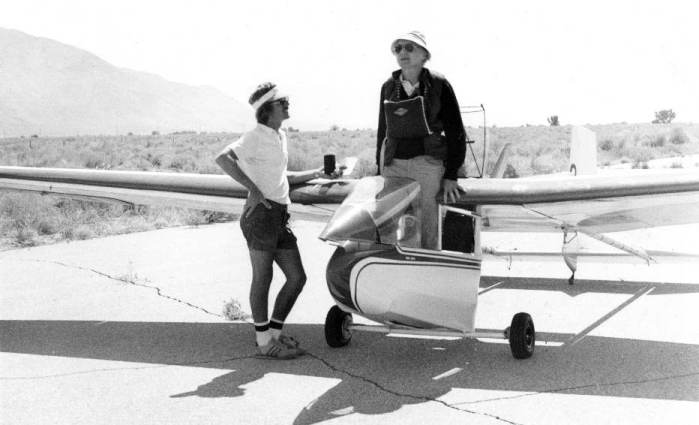
Cantilevered wing. We're very fortunate to have a configuration astoundingly easy to substantially stress test - any time we feel like it in the setup or breakdown area.
What in God's name is the matter with pilots and their absurd excuses for not using simple and readily available and utterly harmless methods of insuring they don't join Rafi Lavin among many others in the hereafter.
Exactly the same thing that's the matter with them when they launch with three hundred dollar helmets, thousand dollar parachutes, and cheap junk excuses for aerotow releases with a buck and a half's worth of materials built around a bent parachute pin - with a few pennies worth of precision fishing line to increase the safety of the towing operation.
If you aren't smart enough to avoid grinding your side wire into a rock with the sole of your shoe then please find another sport because you don't belong in this one.
I dunno... I've pretty much come to the conclusion that hang gliding is the PERFECT sport for people who aren't smart enough to avoid grinding their sidewires into rocks with the soles of their shoes. What else are ya gonna do with them? They’ve earned the sport they have and I'm now content to sit back and enjoy the snuff videos.
Hang gliding isn't for everyone.

http://www.hanggliding.org/viewtopic.php?t=14230
pro tow set-up
Jack Axaopoulos - 2009/11/12 14:49:58 UTC
One of the stated goals of this site is to promote HG. MOST views on this site are NOT from members but from visitors, they have no ignore button.
Having Tad run around every day giving the impression that there is a massive weekly slaughter of pilots at tow parks due to their horribly dangerous devices surely doesnt promote HG. Especially when the safety records are quite excellent.
Like Jim said, theyve gone a decade with no fatalities at their tow park. Pretty damn good I say.
Yet listening to Tad, you would think guys were dying all over the place
He's been nothing but misleading and negative and ignored multiple warnings from me. So He's GONE
Red Howard - 2017/03/21 17:39:19 UTC
Campers,
Yes, outstandingly wise old Jedi Master? You have the undivided attention of us muppets.
75 lbs. (34kg) of foot pressure...
Pounds aren't units of PRESSURE.
...on a slack-rigged wire probably won't hurt anything.
Got that, Wills Wing? Red says you're PROBABLY OK telling your customers to stomp 75 pounds as long as it's a slack rigged glider. You really need to make the distinction between your slack and tight rigged gliders to get this Work Hardening situation under proper control.
You need to have good confidence in what you fly.
- Goddam right. If there's a one in a million chance of Work Hardening a sidewire by stomping 75 pounds the risk simply isn't worth taking. Now make sure to nail that old Frisbee in the middle of the LZ with one of your perfectly timed flares.
- Fuck that, Red. Nobody ever got scratched as a consequence of having too little confidence in something he was flying. The last time Rafi carried his glider to launch he had great confidence in what he was about to fly. It was greatly misplaced and he'd hadn't bothered to perform the brain dead simple and easy procedure that he needed to find out the cheap and painless way.
raquo - 2017/03/21 22:47:40 UTC
Mike Meier got back to me, here's what he said:
Hi Nikita,
That does look like corrosion, and I don't recall seeing that type of corrosion on nico sleeves before.
Probably hasn't ever seen a glider more than three months old.
I'm not sure what would have caused that, but my guess would be that at some point moisture got inside the heatshrink tubing and was trapped there.
I think replacing the wires is prudent, though I suspect that in the condition shown in the photos they would still test to their full rated strength.
- I'd bet a thousand bucks in a heartbeat.
- What about shock load capacity? That really depreciates with age. Everybody knows that.
I don't have any way to ascertain or estimate how much corrosion of the nico sleeve would cause the wire assembly to be weakened below its rated strength. I've never seen a wire failure where the nico itself failed - typically the wire fails where it exits from the nico...
You mean like:
http://www.hanggliding.org/viewtopic.php?t=33308
Funston Accident
Steve Morris - 2015/08/24 23:10:39 UTC
Here is the photo of the damaged wire.

...and this is the normal failure mode even on a brand new wire that tests to full rated strength.
- What are shock loading failure modes?
- While we're on the subject... What's the full rated strength of an appropriate weak link for a Wills Wing glider and how did you make that determination?
Wire failures in the field are most often the result of a wire that has been severely kinked, often because the wire was tensioned with the thimble cocked on the tang, and then the wire has been weakened by repeated loading after having been kinked.
Best not do stomp tests of wires that have been severely kinked. Those would just further shorten their useful life expectancies.
A wire with a severe kink can lose half of its strength after 100 loadings to the equivalent of a one G flight load. Even considering the generally lax maintenance that most hang gliders receive, wire failures in the field are fortunately relatively rare, though they can be catastrophic when they do occur.
I really doubt it. If they really tended to be catastrophic when they occurred wouldn't everybody be doing the stomp test you specify in all your owners' manuals? As far as I can tell they're mostly just harmless inconveniences.
Sincerely,
Mike Meier
Wills Wing
What? No comment on Work Hardening due to normal and overdone stomp tests?
I'm replacing the wires with most corroded nicos - side wires and top front wire, as well as the sweep wire which only has a couple black dots on the nicos but is otherwise old even if it looks good. Nicos on some other wires also have a couple small black dots on them, but it seems like overkill to replace those right now.
All this bullshit you're doing is stupid needless overkill.
I will re-evaluate those nicos in (the sooner of) three months / 10 hours airtime.
Do tell us to how many pounds they test.
NMERider - 2017/03/22 00:47:08 UTC
Thanks you for following through and then following up with information from the source. This is what all pilots should be doing before canvassing the community at large.
Yeah, but Mike said absolutely nothing about the shock loading and Work Hardening issues. So I guess red wins on those by default.
Tom Lyon - 2017/03/22 03:50:32 UTC
Here is a somewhat-related question. I have a Falcon 4 with only 30 hrs total, but it's 3 years old now (I know I need to fly more).
And talk less.
I am meticulous about how I handle the cables...
And what you use for aerotow equipment - only what passes the scrutiny of Dr. Trisa Tilletti.
I do this stress test, and the lower side wires are in great shape.
How do you know they're not critically Work Hardened?
My glider is stored indoors with low humidity in the off-season, etc.
Well then, your wires must be in much better shape than the stuff serving as rigging on all those sailboats docked in the San Francisco Bay area.
I was told...
By whom?
...that in situations like mine where the replacement schedule is long overdue...
Whose replacement schedule and how was it determined? ANYTHING you hear about flying wire replacement schedules is pure unadulterated bullshit. If the wires aren't abused they'll be totally solid for the life of the glider and an eternity beyond.
...but the part is still in great shape and all other factors are considered, that it's an acceptable decision (if I wish) to leave the part (wires in this case) in service.
'Specially when the replacement schedule is just a figure some manufacturer pulled outta his ass for the sole purpose of covering same.
Replacing would certainly be fine, but not necessary simply because of the time that the part has been in service.
See above.
The logic is not based on cost savings...
What's wrong with cost savings. Why should we have the right to stupidly squander finite resources in tribute to totally and obviously fake safety issues?
...but on the possibility of introducing a problem that didn't exist (e.g. installation error on my part)...
Or starting out with a pin that's ALREADY bent for your aerotow release.
...because I was solely honoring time-in-service over other factors. I read a study of aircraft maintenance in WWII that pointed to this as well.
Did you find anything on the Work Hardening of stainless steel cables?
Thoughts?
Nope. Read the forum rules.
I haven't replaced the lower side wires yet, not because of cost, but because I can inspect them so thoroughly, and they are still in nearly new condition.
And you don't know anything from the stress tests you just said you do?
NMERider - 2017/03/22 04:29:55 UTC
JB - Lives have been saved or lost by either incorrectly servicing a part that didn't really need it or by correctly servicing a part that really did need it. Statistically, the world's pilots will probably live longer by replacing their flying wires with new ones at the manufacturer recommended intervals than by relying upon the "If it ain't broke--don't fix it" mentality of bush pilots who have a shorter life expectancy than their air frames. YMMV.
Since it's pretty fuckin' obvious just from this thread alone that wire integrity has absolutely nothing to do with time and absolutely everything to do with physical abuse incidents which occur in fractions of seconds why are we giving these manufacturer specified maintenance schedules the slightest degrees of consideration or respect?
They are LYING to us. If they weren't they'd explain to us how they derived their figures. And that obviously CANNOT be done.
WA6BD - 2017/03/22 04:56:42 UTC
i miss Rafi, when i am at the fort ~
Don't go to the Fort then. Problem solved.
fly safe ~
Wasn't really a flying issue, was it?
---
T2C 154
Predator 142
Saturn 167
YHGA
USHPA # 59216
So had you ever said anything to him about what's in the owner's manual of the first glider you listed relevant to the critical issue? Just kidding.
Rcpilot - 2017/03/22 05:16:28 UTC
I miss him as well. He was a super fun guy to know and interact with.
Well, there is at least a hint of a small silver lining to this one. Now at least at this one flying site there's a healthy awareness of the issue and the locals are all extremely conscientious about doing, looking for, insisting on stomp tests. It's not like his death was just a total senseless waste.
NMERider - 2017/03/22 05:53:57 UTC
I never knew Rafi but I'm certain that I'd have been equally fond of him. I was going through my gmail contacts today and found five entries for fellow pilots who died since I last did an edit which wasn't that long ago. Only one was due to old age.

I don't know shit about Rafi beyond the manner of his death and the relevant issues. But experience tells me that if we could bring him back from the dead or he'd survived with just a good bruising he'd become a Born Again advocate for annual sidewire replacement and give us ZERO help on stomp test advocacy.
http://www.flyfunston.org/bbs/viewtopic.php?f=5&t=1733
Wires
Doug Doerfler - 2015/09/21 23:37 UTC
Did you notice the moron in the video rubs his wire on a big rock when he steps on it, then the second time actually comments to make sure the rock isn't sharp
Tom Lyon - 2017/03/22 16:47:03 UTC
Thanks for your input, NME, and I received a very helpful PM from another experienced .org member as well.
- Experienced .org member. Well practiced at jerking off other experienced .org members.
- Tell me what the fuck EXPERIENCE has to do with ANY of these issues.
I just ordered my new side wires so that I will have them available whether I decide to replace immediately or not.
Good job, Tom. And good luck with your top notch Cloud 9 aerotow equipment and Wrapped and Tied 130 pound Greenspot weak links.
---
Edit - 2017/03/26 21:30:00 UTC
Regarding:
I can't believe I've been this stupid...
above...
Goddammit. I'd already figured that out:
http://www.kitestrings.org/post8412.html#p8412
2015/09/19 09:53:18 UTC
a year and half ago and forgotten I had. Brain's getting seriously fried.


